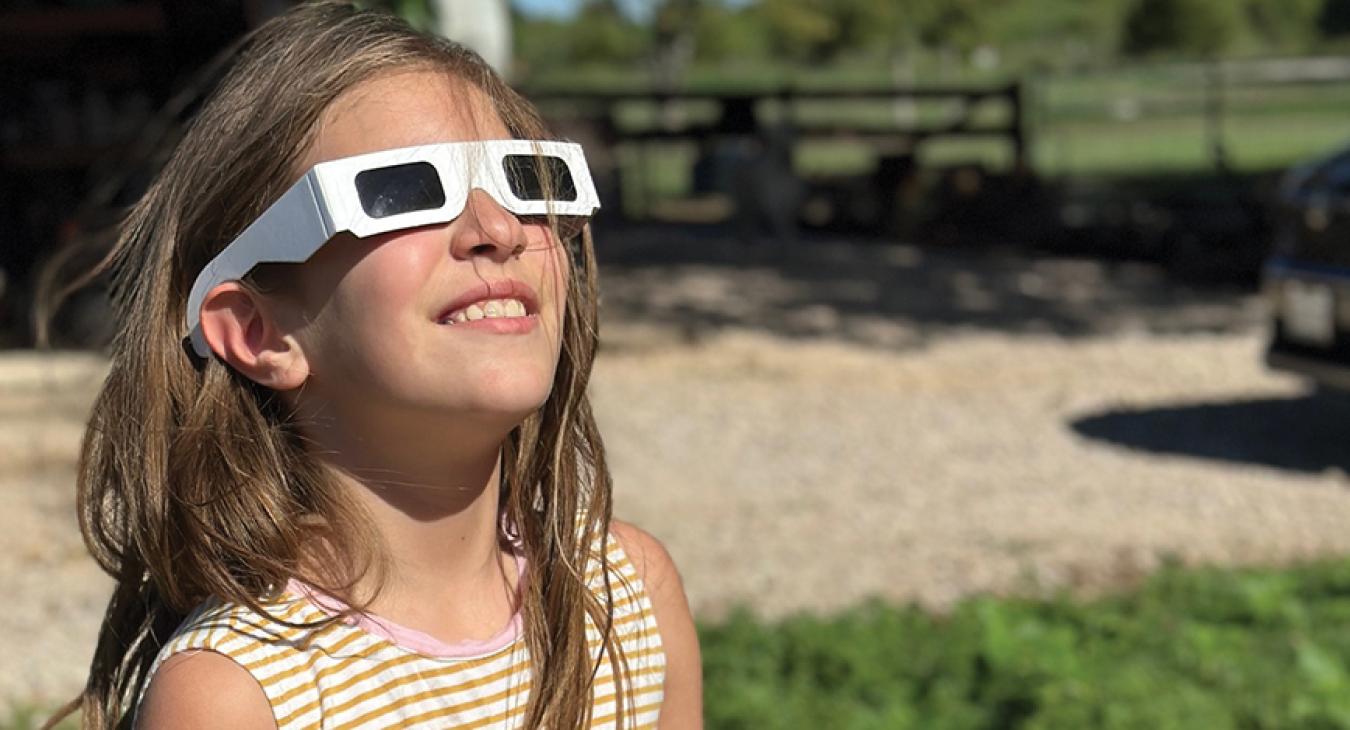Norah Trahan, 9, observes an ‘annular’ solar eclipse over Central Texas in October 2023. Monday, April 8 will bring another solar eclipse to Texas.
On Monday, April 8, residents of the Bluebonnet service area will be treated to a rare celestial event: an eclipse that will darken the midday sun across the region.
By Sharon Jayson
Students across the Bluebonnet Electric Cooperative area are readying special telescopes and protective eyewear. Astronomy experts and photographers are brimming with excitement. Public safety departments are preparing for the likelihood that drivers will abruptly stop to stare into the sky.
That is because Monday, April 8, will not be just a routine school and workday across Central Texas. It is a day that holds the promise of witnessing a once-in-a-lifetime event.
Just after noon, the path of a total solar eclipse will move from south to north over a 100-mile-wide swath of Central Texas. Only a slice of that “zone of totality” will be visible in the Bluebonnet area, in western Manor in Travis County.
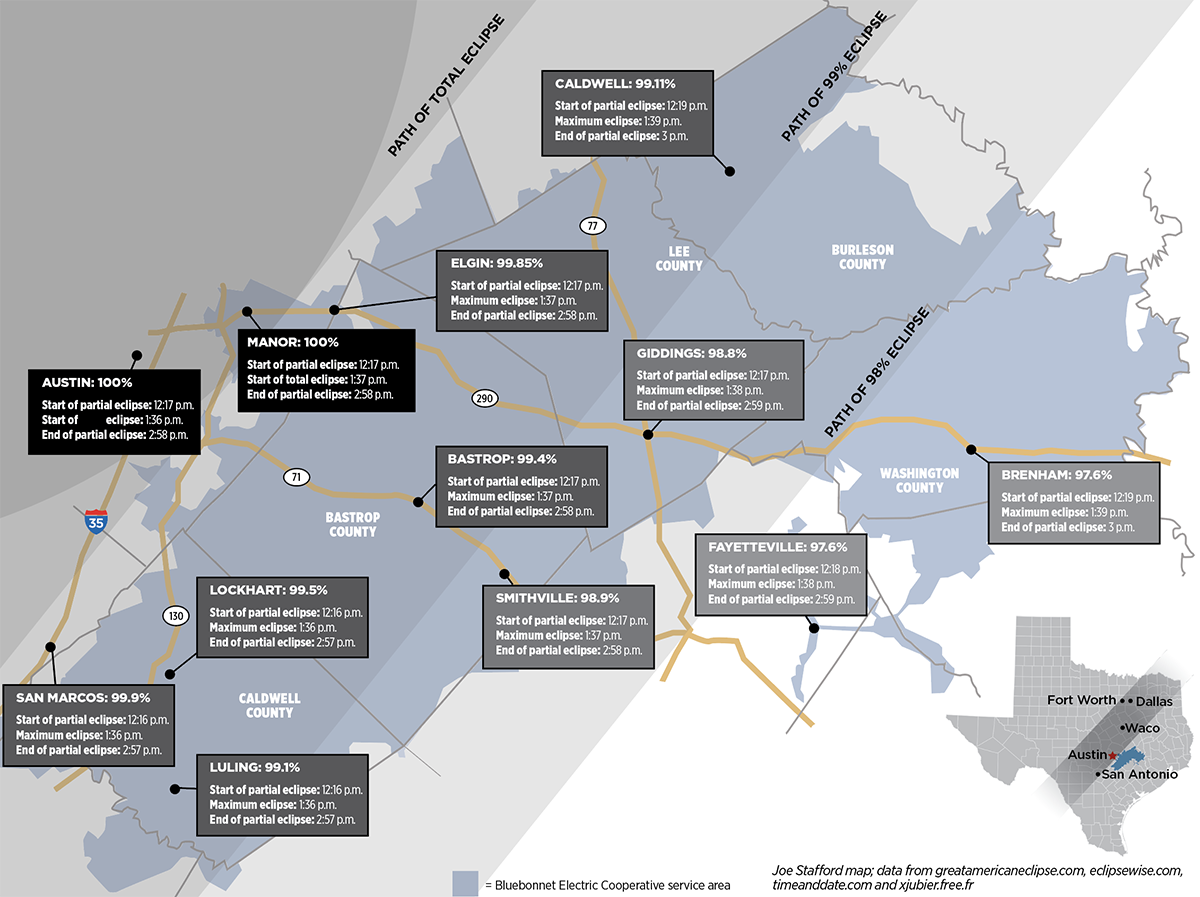
If the sky isn’t cloudy that day in Manor, at 1:37 p.m. people will be able to see the new moon pass precisely between the sun and Earth, blocking the sun’s face and leaving only its outer atmosphere, or “corona,” visible.
But don’t fret if you aren’t in that ideal location. The eclipse will still be a super celestial event across the entire area.

“The sunlight will become dim and eerie, and trees will cast unusual shadows on the ground,” said Michael Zeiler, a geographer and eclipse cartographer.
Bluebonnet members will experience a significant partial eclipse that will darken more than 99% of the sun in Bastrop, Lockhart and Caldwell, as well as southeast Hays County and east Travis County. In Giddings, the moon will cover 98.8% of the sun at the point of totality, and in Fayetteville and Brenham, viewers will see a 97.6% eclipse.
In these areas of partial eclipse, observers will not experience complete darkness. The timing and duration of the partial eclipses, and when they are nearest “totality,” will vary based on location.
It will be quite a cosmic show. Those viewing the eclipse must use protective glasses, pinhole camera/projection boxes or other eclipse-viewing devices, or risk damaging their eyesight.
If you’ve got the time and plan to travel west on April 8, you have a chance to see something that hasn’t happened over Central Texas in 627 years — since 1397.
Thousands of residents of Manor’s ShadowGlen subdivision and nearby areas will briefly experience the April 8 total eclipse for anywhere from 6 to 43 seconds, starting at 1:37 p.m.
For viewers across the Bluebonnet region, the eclipse begins anywhere from 12:16-12:19 p.m., depending on your location. It gradually grows to its maximum, and then begins to return to normal. It will all be over from 2:57-2:59 p.m.
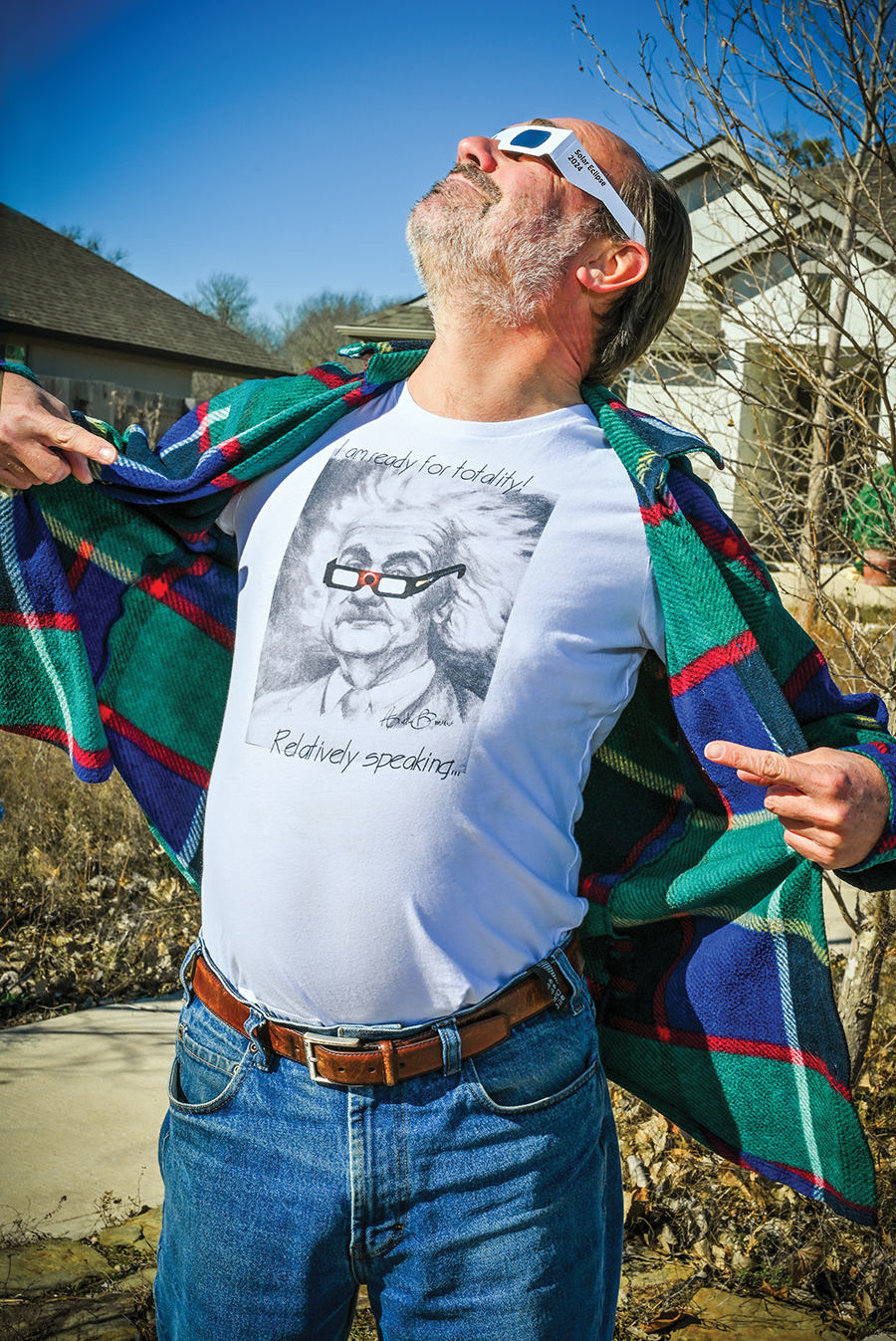
ShadowGlen resident and Bluebonnet Electric Cooperative member Torvald Hessel is an astrophysicist who has seen many partial solar and lunar eclipses. But he’s never been in the area of totality of a solar eclipse.
“I decided that the 2024 eclipse is mine,” he said, noting that his neighborhood’s location in the path of the total eclipse means residents and workers there shouldn’t miss it: “It’s on your doorstep.”
Hessel, an engineering scientist with a master’s degree in astrophysics, conducts research at the University of Texas at Austin’s Space and Geophysics Lab. He spent a dozen years teaching astronomy at Austin Community College.
Hessel calculates that his ShadowGlen neighbors in far western Manor will experience a total eclipse lasting 43 seconds. Because it takes time for eyes to adjust to the darkness, seeing the eclipse for only a few seconds likely won’t give viewers a chance to spot the corona, Hessel said.
“Forty-three (seconds) is better, obviously, but still short, but you may see a star or two popping out,” Hessel said.
Zeiler, who also founded the website greatamericaneclipse.com in 2014, said the total eclipse’s path “neatly bisects the town of Manor.”
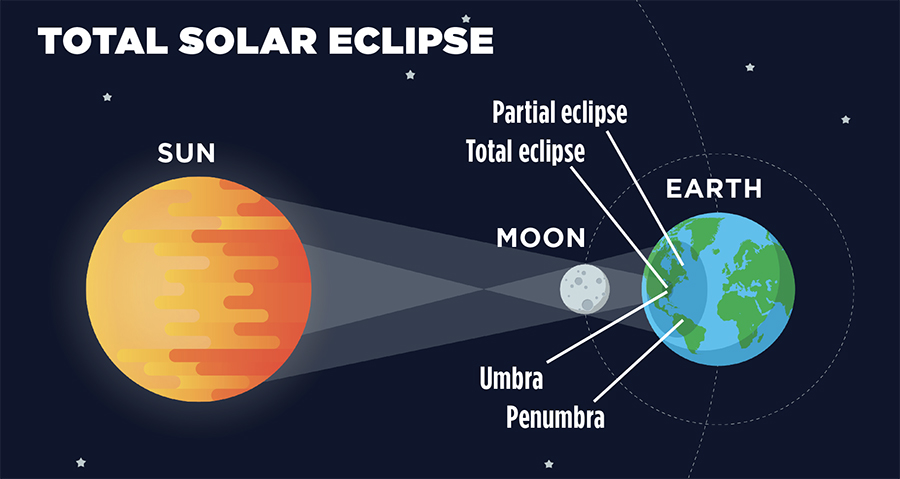
The last total solar eclipse visible over the contiguous United States was Aug. 21, 2017. It lasted just over 2 minutes on a path from the Pacific Northwest to South Carolina. Viewing the next total eclipse visible over the United States, on Aug. 23, 2044, will require a trip to Montana, North Dakota or South Dakota. On Aug. 12, 2045, another total eclipse will just clip the northeast corner of the Texas Panhandle.
“Somewhere on the planet, we usually have a solar eclipse every one or two years — on average about 18 months — but totality is often somewhere that’s not populated, or it’s in the middle of the ocean,” said astronomer Keely Finkelstein, a University of Texas at Austin assistant professor of instruction.
The next time a total solar eclipse is expected to come close to Central Texas will be on April 14, 2200, Zeiler said. That’s about nine generations away.
Claire Hodgin wants to make sure Manor Independent School District students have a memorable experience next month, however brief. “It’s a unique opportunity for students to experience science in their real lives,” said Hodgin, the district’s science coordinator. Older students will look through eclipse glasses. Younger students at Manor Elementary Early Learning Center will use pinhole camera (or projector) boxes — because persuading young children to properly wear eclipse glasses is virtually impossible, she said.
Learning about the eclipse
All of Manor ISD’s 18 schools and its central office will use special Dobsonian telescopes to view the eclipse, Hodgin said. This inexpensive, user-friendly, relatively easy-to-build telescope is popular with amateur astronomers. A group of students and teachers at Manor New Tech High School built 15 of the telescopes, and Hodgin will provide more.
In the Lockhart school district, students in science classes across the district’s nine campuses will watch the eclipse through solar glasses. “We hope this hands-on experience inspires our students to dream big, and that it fuels a lifelong passion for science,” said Ty Davidson, Lockhart’s assistant superintendent of curriculum and instruction.
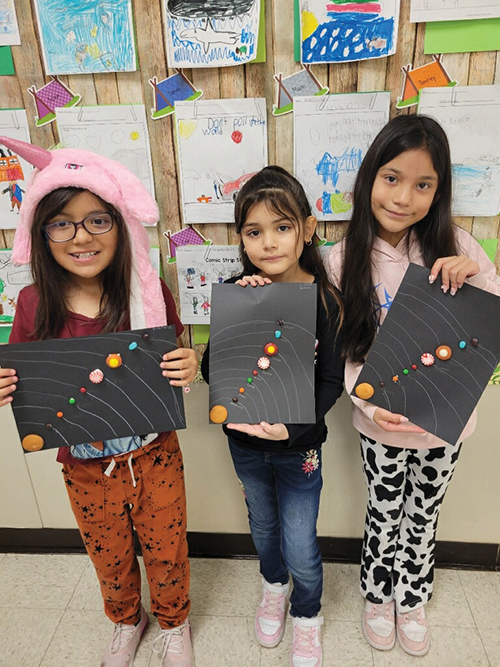
Third-graders in April Zapata’s class at Plum Creek Elementary in the Lockhart ISD had a Zoom conversation with Eliseo Reyes, a flight controller who works with NASA. He talked to students about his work as well as the upcoming eclipse.
Instructors across the Brenham Independent School District are preparing activities to take advantage of the educational opportunities the solar eclipse will offer. Students in science classes will have solar glasses or pinhole viewers to safely view and learn about the eclipse, which will cover 97.6% of the sun in that area. They will also have discussions with teachers, hands-on experiments and interactive simulations.
“By connecting classroom activities to real-world phenomena, we seek to instill a profound sense of curiosity and scientific exploration among our students,” said Brooke Trahan, Brenham ISD’s director of communication and community engagement.
The Houston metro area’s 7 million-plus residents are outside the total eclipse zone, and many of them — as well as others east of the Bluebonnet service area — will travel west through the region. That could snarl area traffic in the days before and after the event.
More than 1 million people might travel within Texas or from elsewhere to see the eclipse, according to Matthew Heinze, Texas Department of Transportation maintenance section manager.
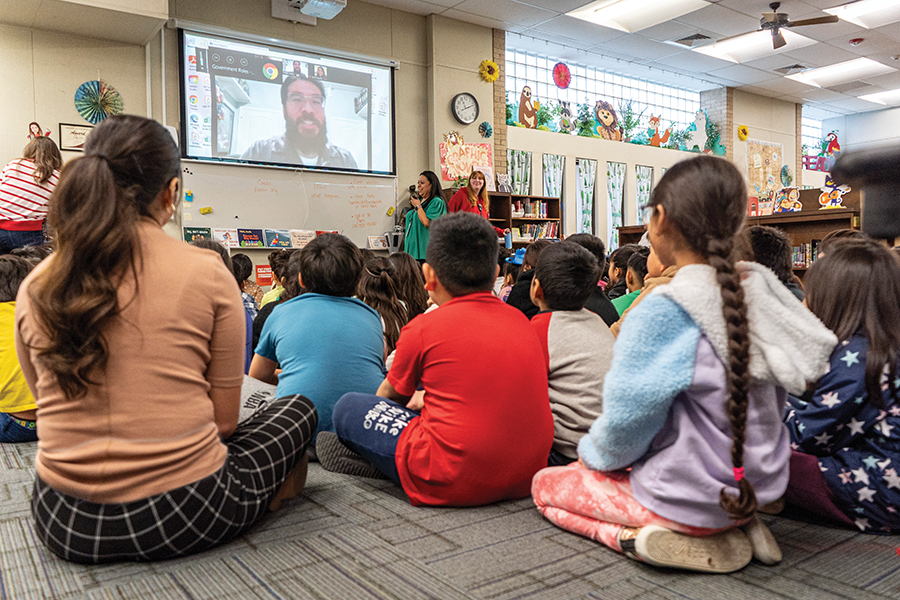
City, county, regional and state governmental agencies responsible for public safety, transportation and tourism have developed plans to handle the crowds, Heinze said.
They sought advice from locations where the 2017 total solar eclipse attracted crowds. “The traffic basically just stopped,” he said. “It was not widespread on every road, but they did have issues with people just stopping to see that.”
On the pre-eclipse weekend, Austin area hotels are expected to be two to three times more full than at the same time last year, according to Visit Austin, a city agency. Expedia Group, a travel technology company, says based on bookings, Austin is one of the top destinations in the United States along the path of the eclipse.
Make plans now
If you were thinking about camping overnight in one of the 31 state parks where the total solar eclipse will be visible, you may be too late. Many are already fully reserved.
Central Texans may remember the annular, “ring of fire,” eclipse last October, when a smaller shadow of the moon passed between Earth and the sun.
Bluebonnet member Debbie Young loved that partial eclipse, which she saw from her and husband Allen Ambuhl’s home in ShadowGlen.
“I’m excited,” Young said of the upcoming event. “I’ve given glasses to some of my family and tried to keep people informed about when it’s going to happen and how to view it safely.”
Although Young is prepared, Hessel doesn’t believe many of his neighbors are aware of what’s in store.
“My experience is people wake up the day before the event in a big panic about who is selling glasses because ‘I need them right now,’ ” he said.
Katie Raney supervises a team at the Texas Parks and Wildlife Department that educates park visitors year-round. She traveled to view the 2017 total solar eclipse in Nebraska and recalls the spectacle.
“The closer you are to totality, the more your body will notice the change in your environment,” she said. “You’ll feel cooler air, see a darker sky and sense a different world than the one you were in before the eclipse started.”
Of course, whether in the center of the total eclipse or in any part of Bluebonnet’s 3,800-square-mile service area, the vagaries of cloud cover loom large.
Hessel isn’t staying home for the eclipse. He’ll be in Bertram to see a little over 4 minutes of totality. If it’s cloudy, he might drive farther.
“I will do my best to find a clear sky,” he said.
Bluebonnet's communities and the solar eclipse
Most of the Bluebonnet service area, which spans about 3,800 square miles in all or part of 14 counties, will see a significant partial solar eclipse.
The light will dim like it does at dawn or dusk and the temperature will become noticeably cooler.
The sun will appear as a very thin crescent. Nocturnal birds and insects may briefly appear or begin making evening sounds.
If you are in the western portion of Manor, the eclipse will briefly be total. For less than a minute, the sky will appear like night and only the sun’s corona will be visible.
Solar eclipse facts for Texas
- The April 8, 2024, total eclipse passes over Texas in about 22 minutes
- Total eclipse begins at the Texas/Mexico border at 1:27 p.m., moves northeast, and leaves Texas at 1:49 p.m.
- Statewide partial eclipse lasts longer, from 12:10-3:06 p.m.
- Most populous area in the path of total eclipse is Dallas/Fort Worth, with about 7 million residents
- 12 million people live within path of total eclipse in Texas, more than any other state in the U.S.

Tips on safe eclipse watching
- Do not stare directly at the sun during the eclipse without protective solar lenses! Looking at the sun at any time without protective lenses can damage the retina quickly and permanently.
- The protective lenses must have a certified mandatory rating of ISO 12312-2.
- Supervise children closely to make sure they are using viewers correctly.
- The American Astronomical Society lists recommended manufacturers of glasses or viewers online at eclipse.aas.org/resources/solar-filters. You may also find viewing glasses at Home Depot, Lowe’s or Walmart.
Safe ways to view
- Eclipse glasses or handheld viewers: They can be inexpensive paper or plastic glasses or viewers, not sunglasses. Certified glasses or viewers are at least 1,000 times darker than sunglasses. Wear them over eyeglasses; check them for scratches or tears. Put them on before you look at the sun.
- Pinhole or box projectors: A pinhole projector is great for children, and can be created as easily as using two pieces of paper, or a colander. Let the sun shine through the pinhole (or the holes of a colander) onto a white piece of paper or surface, then watch the face of the sun disappear and reappear on that surface. A slightly more elaborate but simple box pinhole projector is easy to make: Get directions online or watch NASA’s YouTube video at bit.ly/42dvtDC
- Camera, binocular or telescope lens covers: You can tape the lens from a pair of solar eclipse glasses over the camera lens of your smartphone. Cameras, binoculars and telescopes require special solar lenses that fit over the lens or front of the devices. Consult an expert on recommended filters for these devices.
Sources: Space.com, American Academy of Ophthalmology, astronomer Keely Finkelstein

Planning a public eclipse event?
If you are in the Bluebonnet area and are planning a public solar eclipse-watching event, let us know by emailing socialmedia@bluebonnet.coop. We’ll share it with our followers.
Free eclipse glasses
Bluebonnet Electric Cooperative members can pick up free eclipse viewing glasses, while supplies last, at any of the cooperative’s five member service centers in Bastrop, Brenham, Lockhart, Giddings and Manor. Limit: Two pairs of glasses per member. Member service centers are open from 8 a.m. to 5 p.m. Monday through Friday. Get addresses at bluebonnet.coop/contact-us.
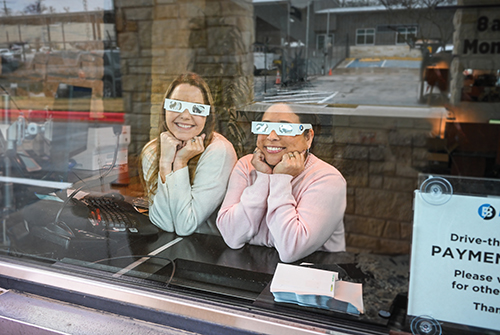
Want some advice?
Thinking about traveling to see the total eclipse? Heed these warnings:
“I really ask for people to have patience. There will no doubt be delays and backups at signals. Everybody be patient.”
-— Matthew Heinze, maintenance section manager,
Texas Department of Transportation
“Do not come to a state park unless you have a reservation, either camping or for day use. And no matter where you go — to a state park or an event — go early and stay late because of the traffic.”
— Katie Raney, field interpretation coordinator,
Texas Parks and Wildlife Department
“If you want to go somewhere to see it, you should go on Saturday or Sunday. Don’t think you can get up and go to your friend’s house that day to watch it, because you’ll get caught up in this traffic that’s coming.”
— Ann Howard, Travis County commissioner, Precinct 3
Get eclipse information
greatamericaneclipse.com/texas-2024-eclipse
eclipsewise.com/2024/2024.html
science.nasa.gov/eclipses Click on the red arrow to get details and maps
timeanddate.com/eclipse/map/2024-april-8 Click on PathMap; then zoom in on the map to locate your area. Click on your area to see details of the full or partial eclipse; “maximum” time is when the eclipse will be at its peak near you.





